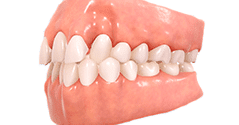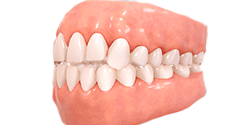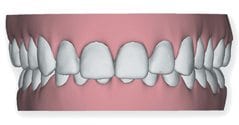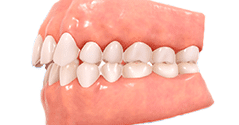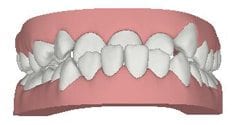Orthodontic Disorders Terms
Overbite occurs when the upper front teeth protrude over the lower front teeth. Generally there is no contact between the upper and lower front teeth. Often you cannot see the lower incisors. Overbite is due to a disproportionate amount of eruption of front teeth, or over development of the bone that supports the teeth, and a front to back discrepancy in the growth of the upper or lower jaw (Class II Relationship). Overbite is also known as a deep bite.
Class II Overjet
Overjet is also known as protrusion. It is where the lower teeth are too far behind the upper front teeth. This can be caused by an improper alignment of the molars (Class II Relationship); a skeletal imbalance of the upper and lower jaw; flared upper incisors; missing lower teeth; or a combination of all the above. In addition, oral habits such as thumb or finger sucking or tongue thrusting can exacerbate the condition.
The lower teeth protrude past the front teeth. An underbite is usually caused by undergrowth of the upper jaw, overgrowth of the lower jaw, or a combination of the two (Class III Relationship). Underbite can also be caused by flared upper incisors, missing lower teeth or a combination of all the above. Early correction of underbite is recommended.
General Terms
A wire engaged in orthodontic attachments, affixed to the crowns of two or more teeth and capable of causing or guiding tooth movement.
A thin metal ring, usually stainless steel, which serves to secure orthodontic attachments to a tooth. The band, with orthodontic attachments welded or soldered to it, is closely adapted to fit the contours of the tooth and then cemented into place.
An orthodontic attachment that is secured to a tooth (either by bonding or banding) for the purpose of engaging an archwire. Brackets can be fabricated from metal, ceramic or plastic.
Crystalline, alumina, tooth-shade or clear synthetic sapphire brackets that are aesthetically more attractive than conventional metal attachments.
Dental misalignment caused by inadequate space for the teeth.
The removal of cemented orthodontic bands.
Used to move teeth in prescribed direction (commonly connected to molar band and upper ball hook). Found in numerous colors for better appearance.
The tissue that surrounds the teeth, consisting of a fibrous tissue that is continuous with the periodontal ligament and mucosal covering.
Generic term for extraoral traction (attached around the back side of the head) for growth modification, tooth movement and anchorage.
Fixed or removable appliance designed commonly for overbite problems and more.
The process of acquiring representations of structures in either two or three dimensions.
Of or pertaining to the tongue. A term used to describe surfaces and directions toward the tongue.
Orthodontic appliances fixed to the lingual surface of the teeth.
Of or pertaining to the upper jaw. May be used to describe teeth, dental restorations, orthodontic appliances or facial structures.
A dental specialist who has completed an advanced post-doctoral course, accredited by the American Dental Association, of at least two academic years in the special area of orthodontics.
Surgery to alter relationships of teeth and/or supporting bones, usually accomplished in conjunction with orthodontic therapy.
Vertical overlapping of upper teeth over lower teeth, usually measured perpendicular to the occlusal plane.
A permanent image, typically on film, produced by ionizing radiation. Sometimes called an X-ray after the most common source of image-producing radiation.
Any orthodontic appliance, fixed or removable, used to maintain the position of the teeth following corrective treatment.
The passive treatment period following active orthodontic correction during which retaining appliances may be used.
A variation of the edgewise appliance in which brackets are angulated to minimize multiple archwire bends. Brackets and molar tubes have specific orientation in three planes of space.

